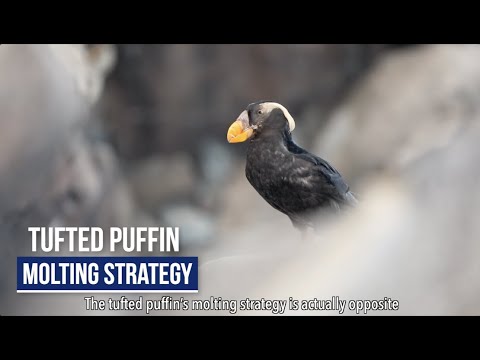*****
Summary of Transcript:
The video explains the molting strategy of tufted puffins, which is opposite from horned puffins. Tufted puffins molt their flight feathers in the fall, after the breeding season when their chicks have fledged. They also start growing their tufts at the end of December and finish growing them by the end of April. They will also molt some of their body and face feathers to look attractive for the breeding season. The video shows a tufted puffin shedding and going through a small body molt to grow its breeding plumage.
*****
Summary of Description:
The content mentions the molting strategy of horned and tufted puffins. It also acknowledges the support of the Royal Caribbean Group for making the program possible.
*****
Exploring the Molting Strategies of Horned and Tufted Puffins
Puffins are charming and charismatic seabirds adored by many people worldwide for their unique appearance and behavior. These seabirds are known for their distinct features, including their brightly colored beaks, webbed feet, and striking black and white plumage. Although all puffin species undergo an annual molting process, recent studies have shown that different species have different molting strategies. This article will explore the molting strategies of two closely related puffin species: horned puffins and tufted puffins.
Horned Puffins’ Molting Strategy
Horned puffins are small seabirds that inhabit coastal regions of North America and Siberia. These birds undergo an annual molt where they shed their old feathers and grow new ones. However, their molting strategy is slightly different from that of tufted puffins. According to studies, horned puffins molt their feathers sequentially and symmetrically. This means they lose feathers symmetrically from both sides of their bodies, allowing them to maintain optimal aerodynamics during their flight. This symmetrical molt also helps the birds to maintain their visual signaling and recognition features, which are essential for their communication and mating processes.
Tufted Puffins’ Molting Strategy
Tufted puffins are another species of seabirds closely related to horned puffins. These birds inhabit the coastal regions of the North Pacific, including Alaska, British Columbia, and Russia. Like horned puffins, tufted puffins also undergo an annual molt, but their molting strategy is slightly different. According to research, tufted puffins molt their feathers in an asynchronous and patterned manner. This means they lose their feathers at other times, allowing them to maintain their flight and insulation abilities. In addition, tufted puffins lose their feathers in a distinctive pattern, replacing their innermost feathers first, followed by the outermost feathers.
Understanding Puffin Molting Strategies
For several reasons, understanding the different molting strategies of horned and tufted puffins is essential. For one, it can help us better appreciate the unique adaptations of these seabirds and how they can thrive in their environments. Additionally, it can help us understand how these birds are affected by environmental changes, such as climate change and pollution.
In recent years, researchers have noted that climate change is having a significant impact on puffin populations. As temperatures continue to rise and sea ice melts, these birds face changes in their food sources, breeding habits, and nesting locations. In some areas, puffin populations have declined by as much as 30 percent over the past few decades. By understanding puffin molting strategies, we can better understand how these birds respond to these environmental changes and what steps we can take to protect them.
Conclusion
In conclusion, horned and tufted puffins are two closely related seabird species with different molting strategies. Horned puffins molt their feathers in a sequential and symmetrical pattern, while tufted puffins molt their feathers in an asynchronous and patterned manner. Understanding these molting strategies is essential for appreciating and protecting these birds due to environmental changes. By continuing to study these fascinating birds, we can gain insights into their unique adaptations and help ensure their long-term survival.
*****
Source Description
Do horned puffins and tufted puffins have the same molting strategy? Han, the tufted puffin, helps us understand his species’ yearly process for molting their feathers.
This “Virtual Visit” episode is made possible by the generous support of our sponsors. Thank you, Royal Caribbean Group, for making this free program possible!


